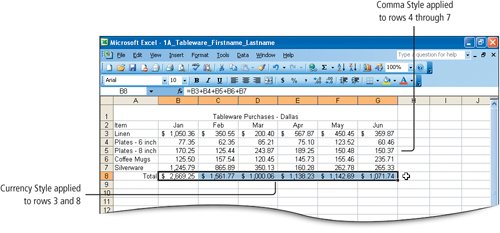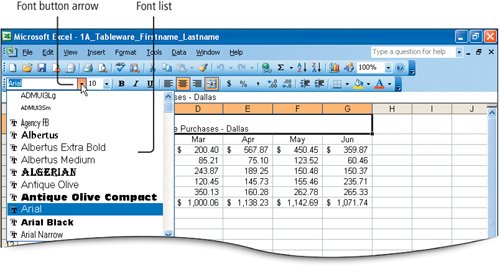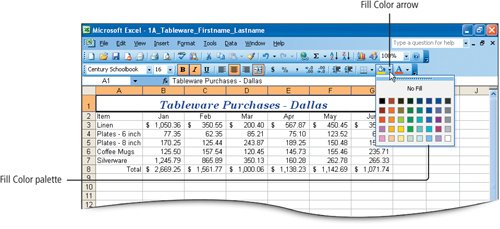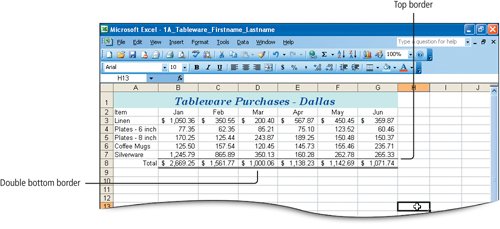Objective 5. Format Data and Cells
Excel has many options for displaying numbersthink of percentages, fractions, or money. Recall that Excel refers to the various ways to write numbers as number formats. Some common number formats are those used for reporting financial information like the purchases for a restaurant.
Formatting is the process of determining the appearance of cells and the overall layout of a worksheet. Formatting is accomplished through commands on both the Formatting toolbar and in the Format Cells dialog box.
Activity 1.10. Formatting Financial Numbers
The General format is the default format for a number that you type in a cell. Unless you apply a different number format to a cell, Excel will use the General format. The General format displays a number exactly as you type itwith three exceptions, as noted in the table in Figure 1.47.
|
Number Format |
Description |
|---|---|
|
General |
The General format is the default format for a number that you type in a cell. The General format displays a number exactly as you type itwith three exceptions:
|
|
Number |
Number format is used for the general display of noncurrency numbers. The default format has two decimal places, and you may choose to check the option for using a comma as a thousand separator. Negative numbers can display in red, be preceded by a minus sign, be enclosed in parentheses, or display both in red and in parentheses. |
|
Currency |
Currency format is used for general monetary values, and you can select from a list of worldwide currency symbolsthe U.S. dollar sign is the default symbol. When you click the Currency Style button on the Formatting toolbar, you apply the default Accounting format, which uses the U.S. dollar sign. |
|
Accounting |
Accounting format is similar to Currency format with two differencesthe dollar sign (or other currency symbol) always displays at the left edge of the cell, rather than flush against the first number. Thus, both dollar signs and numbers are vertically aligned in the same column. Also, Accounting format adds a blank space equal to the width of a close parenthesis on the right side of positive values to ensure that decimal points align if a column has both positive and negative numbers. This may cause misalignment with other formats that use different methods to indicate negative numbers. |
|
Date |
Date format provides many common ways to display dates. The default format in the Format Cells dialog box is month, day, and year, separated by a slash. The year displays as four digits by default, but may be changed in the Control Panel to a two-digit display. |
|
Time |
Time format provides many common ways to display time. The default format in the Format Cells dialog box is the hour and minute. |
|
Percentage |
Percentage format multiplies the cell value by 100 and displays the result with a percent sign. The default is two decimal places. |
|
Fraction |
Fraction format displays fractional amounts as actual fractions rather than as decimal values. The first three formats use single-digit, double-digit, and triple-digit numerators and denominators. For example, the single-digit format rounds to the nearest value that can be represented as a single-digit fraction. |
|
Scientific |
Scientific format displays numbers in scientific (exponential) notation. This is useful for extremely large numbers. |
|
Text |
Text format treats a number as if it were text. The number is left aligned like text. |
|
Special |
Special formats are used primarily with database functions. You can type postal codes, telephone numbers, and taxpayer ID numbers quickly without having to enter the punctuation. |
|
Custom |
Custom format is used to create your own number format. For example, perhaps your organization has a special format for invoice numbers. |
|
|
|
|
1. |
From the Format menu, click Cells to display the Format Cells dialog box, and then click the Number tab. Click each format under Category, and as you do so, take a moment to study the information about each Number format in the table in Figure 1.47. |
|
2. |
In the Format Cells dialog box, click Cancel. Select the range B3:G3. On the Formatting toolbar, click the Currency Style button |
|
3. |
Select the range B4:G7, and then on the Formatting toolbar, click the Comma Style button |
|
4. |
Click cell B3. On the Standard toolbar, click the Format Painter button Figure 1.48. (This item is displayed on page 627 in the print version) 
The Currency Style is applied to the totals. When preparing worksheets with financial information, the first row of dollar amounts and the total rows of dollar amounts are formatted in the Currency Style; that is, with thousand comma separators, dollar signs, two decimal places, and space at the right to accommodate a parenthesis for negative numbers, if any. Rows that are not the first row or the total row should be formatted with the Comma Style. |
|
|
|
|
5. |
On the Standard toolbar, click the Save button NoteUsing Negative Numbers in a Worksheet You can see a small amount of space to the right of each of the formatted number cells. The formats you applied allow this space in the event parentheses are needed to indicate negative numbers. If your worksheet contains negative numbers, display the Format Cells dialog box and select from among various formats to accommodate negative numbers. As you progress in your study of Excel, you will practice formatting negative numbers. |
Activity 1.11. Formatting Text from the Dialog Box or the Toolbar
Format text in an Excel worksheet using techniques similar to those you use in other Microsoft Office applications such as Word. For example, you can change fonts; add emphasis by using bold, italic, and underline; and align text in the center, or at the left or right edge of a cell. Applying borders to cells is also useful to visually separate cells. In this activity, you will format the title to increase its visibility and inform the user of the worksheet's purpose as soon as the worksheet is displayed.
|
1. |
Click cell A1, which contains the merged and centered text Tableware Purchases Dallas. On the Formatting toolbar, click the Font button arrow Figure 1.49. 
|
|
2. |
From the displayed list, press |
|
3. |
With cell A1 still selected, on the Formatting toolbar click the Font Size button arrow |
|
4. |
With cell A1 selected, on the Formatting toolbar click the Bold button |
|
5. |
With cell A1 still selected, display the Format menu, and then click Cells to display the Format Cells dialog box. Click the Font tab. Under Font, notice that Century Schoolbook is selected and that a preview of the font is also displayed under Preview. |
|
6. |
Under Font style, click Bold Italic, and notice that the Preview changes to reflect your selection. Click the Color arrow. From the displayed color palette, in the first row, click the sixth colorDark Blue. Click OK. |
|
7. |
With cell A1 still selected, on the Formatting toolbar click the Underline button You can apply some common formats from buttons on the toolbar like this one. The Underline button places a single underline under the contents of a cell. The Bold, Italic, and Underline buttons on the Formatting toolbar are toggle buttons, which means that you can click them once to turn the formatting on and click again to turn it off. |
|
8. |
With cell A1 selected, on the Formatting toolbar click the Underline |
|
9. |
With cell A1 selected, on the Formatting toolbar click the Fill Color button arrow Figure 1.50. 
|
|
10. |
On the displayed color palette, in the last row, click the fifth colorLight Turquoise. |
|
11. |
Select the range B8:G8. On the Formatting toolbar, click the Borders button arrow Figure 1.51. 
|
|
12. |
On the displayed table of border options, in the second row, click the fourth border designTop and Double Bottom Border. Click any empty cell to deselect the range, and then compare your screen with Figure 1.52. Figure 1.52. 
This is a common way to apply borders to financial information. The single border indicates that calculations were performed on the numbers above, and the double border indicates that the information is complete. |
|
13. |
On the Standard toolbar, click the Save button |
Objective 6 Chart Data |
Windows XP
- Chapter One. Getting Started with Windows XP
- Project 1A. Windows XP
- Objective 1. Get Started with Windows XP
- Objective 2. Resize, Move, and Scroll Windows
- Objective 3. Maximize, Restore, Minimize, and Close a Window
- Objective 4. Create a New Folder
- Objective 5. Copy, Move, Rename, and Delete Files
- Objective 6. Find Files and Folders
- Objective 7. Compress Files
- Summary
- Key Terms
- Concepts Assessments
Outlook 2003
- Chapter One. Getting Started with Outlook 2003
- Getting Started with Microsoft Office Outlook 2003
- Project 1A. Exploring Outlook 2003
- Objective 1. Start and Navigate Outlook
- Objective 2. Read and Respond to E-mail
- Objective 3. Store Contact and Task Information
- Objective 4. Work with the Calendar
- Objective 5. Delete Outlook Information and Close Outlook
- Summary
- Key Terms
- Concepts Assessments
- Skill Assessments
- Performance Assessments
- Mastery Assessments
- Problem Solving
- GO! with Help
Internet Explorer
- Chapter One. Getting Started with Internet Explorer
- Getting Started with Internet Explorer 6.0
- Project 1A. College and Career Information
- Objective 1. Start Internet Explorer and Identify Screen Elements
- Objective 2. Navigate the Internet
- Objective 3. Create and Manage Favorites
- Objective 4. Search the Internet
- Objective 5. Save and Print Web Pages
- Summary
- Key Terms
- Concepts Assessments
- Skill Assessments
- Performance Assessments
- Mastery Assessments
- Problem Solving
Computer Concepts
- Chapter One. Basic Computer Concepts
- Objective 1. Define Computer and Identify the Four Basic Computing Functions
- Objective 2. Identify the Different Types of Computers
- Objective 3. Describe Hardware Devices and Their Uses
- Objective 4. Identify Types of Software and Their Uses
- Objective 5. Describe Networks and Define Network Terms
- Objective 6. Identify Safe Computing Practices
- Summary
- In this Chapter You Learned How to
- Key Terms
- Concepts Assessments
Word 2003
Chapter One. Creating Documents with Microsoft Word 2003
- Chapter One. Creating Documents with Microsoft Word 2003
- Getting Started with Microsoft Office Word 2003
- Project 1A. Thank You Letter
- Objective 1. Create and Save a New Document
- Objective 2. Edit Text
- Objective 3. Select, Delete, and Format Text
- Objective 4. Create Footers and Print Documents
- Project 1B. Party Themes
- Objective 5. Navigate the Word Window
- Objective 6. Add a Graphic to a Document
- Objective 7. Use the Spelling and Grammar Checker
- Objective 8. Preview and Print Documents, Close a Document, and Close Word
- Objective 9. Use the Microsoft Help System
- Summary
- Key Terms
- Concepts Assessments
- Skill Assessments
- Performance Assessments
- Mastery Assessments
- Problem Solving
- You and GO!
- Business Running Case
- GO! with Help
Chapter Two. Formatting and Organizing Text
- Formatting and Organizing Text
- Project 2A. Alaska Trip
- Objective 1. Change Document and Paragraph Layout
- Objective 2. Change and Reorganize Text
- Objective 3. Create and Modify Lists
- Project 2B. Research Paper
- Objective 4. Insert and Format Headers and Footers
- Objective 5. Insert Frequently Used Text
- Objective 6. Insert and Format References
- Summary
- Key Terms
- Concepts Assessments
- Skill Assessments
- Performance Assessments
- Mastery Assessments
- Problem Solving
- You and GO!
- Business Running Case
- GO! with Help
Chapter Three. Using Graphics and Tables
- Using Graphics and Tables
- Project 3A. Job Opportunities
- Objective 1. Insert and Modify Clip Art and Pictures
- Objective 2. Use the Drawing Toolbar
- Project 3B. Park Changes
- Objective 3. Set Tab Stops
- Objective 4. Create a Table
- Objective 5. Format a Table
- Objective 6. Create a Table from Existing Text
- Summary
- Key Terms
- Concepts Assessments
- Skill Assessments
- Performance Assessments
- Mastery Assessments
- Problem Solving
- You and GO!
- Business Running Case
- GO! with Help
Chapter Four. Using Special Document Formats, Columns, and Mail Merge
- Using Special Document Formats, Columns, and Mail Merge
- Project 4A. Garden Newsletter
- Objective 1. Create a Decorative Title
- Objective 2. Create Multicolumn Documents
- Objective 3. Add Special Paragraph Formatting
- Objective 4. Use Special Character Formats
- Project 4B. Water Matters
- Objective 5. Insert Hyperlinks
- Objective 6. Preview and Save a Document as a Web Page
- Project 4C. Recreation Ideas
- Objective 7. Locate Supporting Information
- Objective 8. Find Objects with the Select Browse Object Button
- Project 4D. Mailing Labels
- Objective 9. Create Labels Using the Mail Merge Wizard
- Summary
- Key Terms
- Concepts Assessments
- Skill Assessments
- Performance Assessments
- Mastery Assessments
- Problem Solving
- You and GO!
- Business Running Case
- GO! with Help
Excel 2003
Chapter One. Creating a Worksheet and Charting Data
- Creating a Worksheet and Charting Data
- Project 1A. Tableware
- Objective 1. Start Excel and Navigate a Workbook
- Objective 2. Select Parts of a Worksheet
- Objective 3. Enter and Edit Data in a Worksheet
- Objective 4. Construct a Formula and Use the Sum Function
- Objective 5. Format Data and Cells
- Objective 6. Chart Data
- Objective 7. Annotate a Chart
- Objective 8. Prepare a Worksheet for Printing
- Objective 9. Use the Excel Help System
- Project 1B. Gas Usage
- Objective 10. Open and Save an Existing Workbook
- Objective 11. Navigate and Rename Worksheets
- Objective 12. Enter Dates and Clear Formats
- Objective 13. Use a Summary Sheet
- Objective 14. Format Worksheets in a Workbook
- Summary
- Key Terms
- Concepts Assessments
- Skill Assessments
- Performance Assessments
- Mastery Assessments
- Problem Solving
- You and GO!
- Business Running Case
- GO! with Help
Chapter Two. Designing Effective Worksheets
- Designing Effective Worksheets
- Project 2A. Staff Schedule
- Objective 1. Use AutoFill to Fill a Pattern of Column and Row Titles
- Objective 2. Copy Text Using the Fill Handle
- Objective 3. Use AutoFormat
- Objective 4. View, Scroll, and Print Large Worksheets
- Project 2B. Inventory Value
- Objective 5. Design a Worksheet
- Objective 6. Copy Formulas
- Objective 7. Format Percents, Move Formulas, and Wrap Text
- Objective 8. Make Comparisons Using a Pie Chart
- Objective 9. Print a Chart on a Separate Worksheet
- Project 2C. Population Growth
- Objective 10. Design a Worksheet for What-If Analysis
- Objective 11. Perform What-If Analysis
- Objective 12. Compare Data with a Line Chart
- Summary
- Key Terms
- Concepts Assessments
- Skill Assessments
- Performance Assessments
- Mastery Assessments
- Problem Solving
- You and GO!
- Business Running Case
- GO! with Help
Chapter Three. Using Functions and Data Tables
- Using Functions and Data Tables
- Project 3A. Geography Lecture
- Objective 1. Use SUM, AVERAGE, MIN, and MAX Functions
- Objective 2. Use a Chart to Make Comparisons
- Project 3B. Lab Supervisors
- Objective 3. Use COUNTIF and IF Functions, and Apply Conditional Formatting
- Objective 4. Use a Date Function
- Project 3C. Loan Payment
- Objective 5. Use Financial Functions
- Objective 6. Use Goal Seek
- Objective 7. Create a Data Table
- Summary
- Key Terms
- Concepts Assessments
- Skill Assessments
- Performance Assessments
- Mastery Assessments
- Problem Solving
- You and GO!
- Business Running Case
- GO! with Help
Access 2003
Chapter One. Getting Started with Access Databases and Tables
- Getting Started with Access Databases and Tables
- Project 1A. Academic Departments
- Objective 1. Rename a Database
- Objective 2. Start Access, Open an Existing Database, and View Database Objects
- Project 1B. Fundraising
- Objective 3. Create a New Database
- Objective 4. Create a New Table
- Objective 5. Add Records to a Table
- Objective 6. Modify the Table Design
- Objective 7. Create Table Relationships
- Objective 8. Find and Edit Records in a Table
- Objective 9. Print a Table
- Objective 10. Close and Save a Database
- Objective 11. Use the Access Help System
- Summary
- Key Terms
- Concepts Assessments
- Skill Assessments
- Performance Assessments
- Mastery Assessments
- Problem Solving Assessments
- Problem Solving
- You and GO!
- Business Running Case
- GO! with Help
Chapter Two. Sort, Filter, and Query a Database
- Sort, Filter, and Query a Database
- Project 2A. Club Fundraiser
- Objective 1. Sort Records
- Objective 2. Filter Records
- Objective 3. Create a Select Query
- Objective 4. Open and Edit an Existing Query
- Objective 5. Sort Data in a Query
- Objective 6. Specify Text Criteria in a Query
- Objective 7. Print a Query
- Objective 8. Specify Numeric Criteria in a Query
- Objective 9. Use Compound Criteria
- Objective 10. Create a Query Based on More Than One Table
- Objective 11. Use Wildcards in a Query
- Objective 12. Use Calculated Fields in a Query
- Objective 13. Group Data and Calculate Statistics in a Query
- Summary
- Key Terms
- Concepts Assessments
- Skill Assessments
- Performance Assessments
- Mastery Assessments
- Problem Solving
- You and GO!
- Business Running Case
- GO! with Access Help
Chapter Three. Forms and Reports
- Forms and Reports
- Project 3A. Fundraiser
- Objective 1. Create an AutoForm
- Objective 2. Use a Form to Add and Delete Records
- Objective 3. Create a Form Using the Form Wizard
- Objective 4. Modify a Form
- Objective 5. Create an AutoReport
- Objective 6. Create a Report Using the Report Wizard
- Objective 7. Modify the Design of a Report
- Objective 8. Print a Report and Keep Data Together
- Summary
- Key Terms
- Concepts Assessments
- Skill Assessments
- Performance Assessments
- Mastery Assessments
- Problem Solving
- You and GO!
- Business Running Case
- GO! with Help
Powerpoint 2003
Chapter One. Getting Started with PowerPoint 2003
- Getting Started with PowerPoint 2003
- Project 1A. Expansion
- Objective 1. Start and Exit PowerPoint
- Objective 2. Edit a Presentation Using the Outline/Slides Pane
- Objective 3. Format and Edit a Presentation Using the Slide Pane
- Objective 4. View and Edit a Presentation in Slide Sorter View
- Objective 5. View a Slide Show
- Objective 6. Create Headers and Footers
- Objective 7. Print a Presentation
- Objective 8. Use PowerPoint Help
- Summary
- Key Terms
- Concepts Assessments
- Skill Assessments
- Performance Assessments
- Mastery Assessments
- Problem Solving
- You and GO!
- Business Running Case
- GO! with Help
Chapter Two. Creating a Presentation
- Creating a Presentation
- Project 2A. Teenagers
- Objective 1. Create a Presentation
- Objective 2. Modify Slides
- Project 2B. History
- Objective 3. Create a Presentation Using a Design Template
- Objective 4. Import Text from Word
- Objective 5. Move and Copy Text
- Summary
- Key Terms
- Concepts Assessments
- Skill Assessments
- Performance Assessments
- Mastery Assessments
- Problem Solving
- You and GO!
- Business Running Case
- GO! with Help
Chapter Three. Formatting a Presentation
- Project 3A. Emergency
- Objective 1. Format Slide Text
- Objective 2. Modify Placeholders
- Objective 3. Modify Slide Master Elements
- Objective 4. Insert Clip Art
- Project 3B. Volunteers
- Objective 5. Apply Bullets and Numbering
- Objective 6. Customize a Color Scheme
- Objective 7. Modify the Slide Background
- Objective 8. Apply an Animation Scheme
- Summary
- Key Terms
- Concepts Assessments
- Skill Assessments
- Performance Assessments
- Mastery Assessments
- Problem Solving
- You and GO!
- Business Running Case
- GO! with Help
Integrated Projects
Chapter One. Using Access Data with Other Office Applications
- Chapter One. Using Access Data with Other Office Applications
- Introduction
- Project 1A. Meeting Slides
- Objective 1. Export Access Data to Excel
- Objective 2. Create a Formula in Excel
- Objective 3. Create a Chart in Excel
- Objective 4. Copy Access Data into a Word Document
- Objective 5. Copy Excel Data into a Word Document
- Objective 6. Insert an Excel Chart into a PowerPoint Presentation
Chapter Two. Using Tables in Word and Excel
- Chapter Two. Using Tables in Word and Excel
- Introduction
- Project 2A. Meeting Notes
- Objective 1. Plan a Table in Word
- Objective 2. Enter Data and Format a Table in Word
- Objective 3. Create a Table in Word from Excel Data
- Objective 4. Create Excel Worksheet Data from a Word Table
Chapter Three. Using Excel as a Data Source in a Mail Merge
- Chapter Three. Using Excel as a Data Source in a Mail Merge
- Introduction
- Project 3A. Mailing Labels
- Objective 1. Prepare a Mail Merge Document as Mailing Labels
- Objective 2. Choose an Excel Worksheet as a Data Source
- Objective 3. Produce and Save Merged Mailing Labels
- Objective 4. Open a Saved Main Document for Mail Merge
Chapter Four. Linking Data in Office Documents
- Chapter Four. Linking Data in Office Documents
- Introduction
- Project 4A. Weekly Sales
- Objective 1. Insert and Link in Word an Excel Object
- Objective 2. Format an Object in Word
- Objective 3. Open a Word Document That Includes a Linked Object, and Update Links
Chapter Five. Creating Presentation Content from Office Documents
EAN: 2147483647
Pages: 448
 .
. .
. . With the Format Painter pointera small paint brush attached to the mouse pointerselect the range B8:G8. Compare your screen with Figure 1.48.
. With the Format Painter pointera small paint brush attached to the mouse pointerselect the range B8:G8. Compare your screen with Figure 1.48. .
. , and then compare your screen with Figure 1.49.
, and then compare your screen with Figure 1.49. to move to fonts whose names begin with C, and then scroll as necessary to locate and then click Century Schoolbook. If Century Schoolbook is not available on your Font list, select Times New Roman.
to move to fonts whose names begin with C, and then scroll as necessary to locate and then click Century Schoolbook. If Century Schoolbook is not available on your Font list, select Times New Roman. , and then from the displayed list, click 16.
, and then from the displayed list, click 16. .
. .
. to display the color palette, and then compare your screen with Figure 1.50.
to display the color palette, and then compare your screen with Figure 1.50. to display commonly used border designs. Compare your screen with Figure 1.51.
to display commonly used border designs. Compare your screen with Figure 1.51.